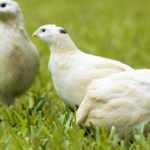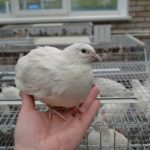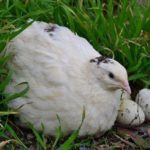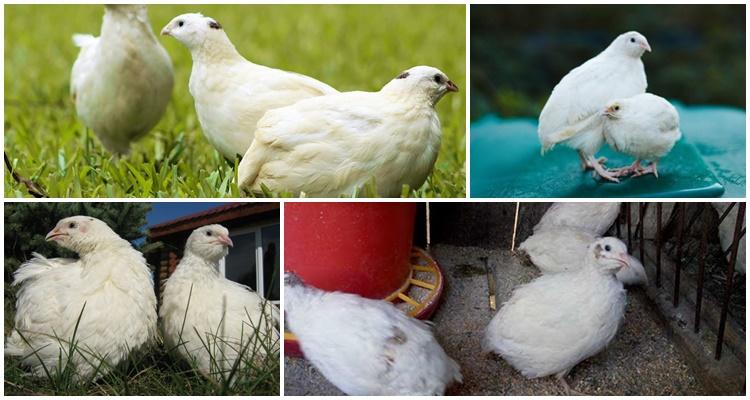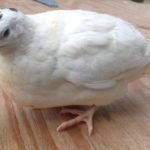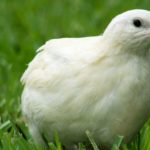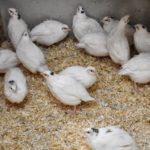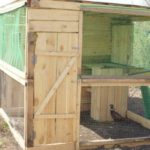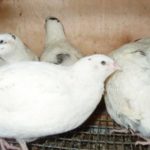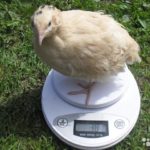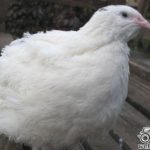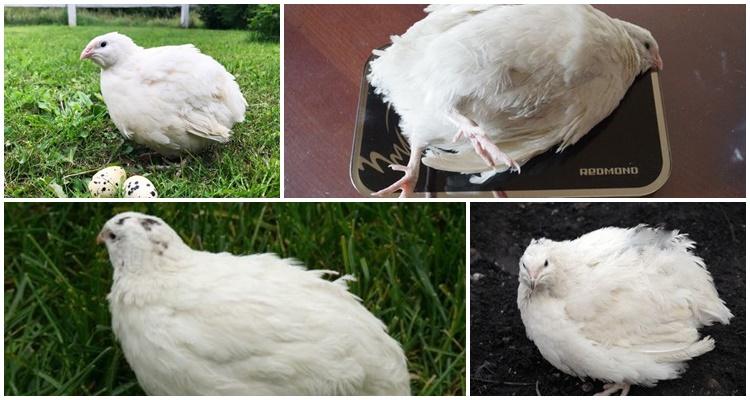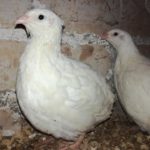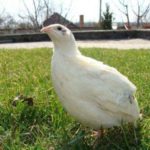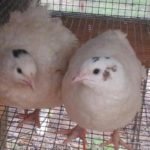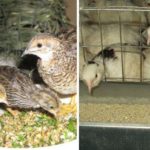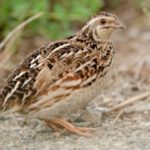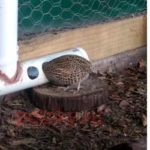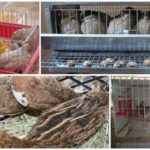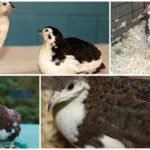Texas quails are raised by farmers who appreciate not only the benefits of eggs, but also the taste of dietary tender meat. Adult birds gain up to 800 grams of weight. Because of these properties, the breed received the unofficial name of the white giant. Caring for the bird is easy. Even beginners can cope with breeding albinos. But you need to know some features of the content.
- History of the breed
- Appearance and performance of Texas quail
- Advantages and disadvantages
- How to distinguish a female from a male?
- Features of maintenance and care
- Lighting
- Ventilation
- Cells
- Temperature
- Air humidity
- Diet
- Slaughter and culling
- Subtleties of breeding
- Frequent illnesses
- Approximate cost and where to buy
History of the breed
American breeders worked to create the species. The breed was bred in the state of Texas, which was the reason for assigning the name to the snow-white birds. The quail's coloring came from its English ancestors. Among the plumage there are several black inclusions. In purebred individuals, a dark spot is located on the head. The presence of 3 marks is considered normal. Texans inherited their large size from the Japanese breed. Today, white giants are in demand all over the world. In Russia, quails were first bred to produce eggs. But today meat is also popular in the consumer market.
Appearance and performance of Texas quail
Texas quail have a number of distinctive external features:
- The bird's body is large, with a protruding chest and a straight back.
- The head size is small.
- The pink tint of the beak is not only a sign of the breed, but also a characteristic of the bird’s health.
- The thick plumage is white with a black spot on the top.
Texans are the largest quail species. Albinos grow up quickly. Table of weight that birds gain by week:
| Age, in weeks | Body weight, g |
| 1 | 30 |
| 2 | up to 150 |
| 4 | up to 260 |
| 6 | up to 390 |
| 8 | 400 and more |
Females are usually larger than their male counterparts. And representatives of other breeds, Texas quails are one and a half times larger in size. With good care, giants gain 700-800 grams of weight. Birds begin to lay eggs when they are almost 2 months old. On average, egg production per year is 260 eggs, weighing 16 grams each, or 4 per week.
Advantages and disadvantages
Texans compare favorably with other quail. But, along with advantages, birds also have disadvantages.
It is also difficult to distinguish a male from a quail until a certain age. Sexual characteristics appear when it is time to lay eggs.
How to distinguish a female from a male?
Among young animals, during the first 2 months of life, males and females look the same. Broiler breeds mature at the age of 50 days. To find out the sex of a Texas quail, you need to:
- Take the bird in your hands and place it on its back.
- Carefully spread the feathers in the area of the anal canal.
- In females, the area around the passage is pink and smooth.
- The male genital organ looks like a small growth, when pressed, a small amount of white foam comes out.
An indirect sign of the feminine gender is a more melodic chirping. Quails make sharp and abrupt sounds.
Features of maintenance and care
Calm and peaceful, Texas quails require little care. But this does not mean that farmers should not adhere to the rules when breeding.
Lighting
When keeping them at home, they pay great attention to lighting issues. Texas quail do not like bright light. It is preferable to choose a room with windows facing south or east. Cover openings with mesh or light cloth. But birds will perceive the early onset of darkness negatively.The livestock's day lasts up to 18 hours. After sunset, several lamps with a power of 40, maximum 60 W are turned on. Newborn birds require light around the clock.
Ventilation
The air in the quail pen must be fresh, so the room is ventilated and ventilation is monitored. For slow-moving birds, walks in a spacious yard are beneficial. In crowded conditions, large broilers begin to show signs of restlessness. To protect against rats, dogs or cats, it is better to fence the area with a mesh fence. A canopy will protect Texas quail from the bright sun.
Cells
When keeping birds in cages, a number of conditions are observed:
- For each individual, a compartment measuring 35x45 centimeters and up to 40 centimeters in height is allocated.
- Feeders and water containers are installed on the outside.
- Retractable trays are installed to remove litter.
Poultry farmers also advise keeping quails separated by gender. Cages for laying hens are equipped with egg collectors to prevent crushing of the fragile product.
Temperature
The productivity of Texas quail is affected by temperature. The cold causes birds to huddle together. Tightness and nervousness often lead to injuries. Excess heat has a negative impact on well-being. In the heat, birds experience shortness of breath. A comfortable temperature is 20 °C.
Air humidity
Humidity levels affect the health of birds. 60-70% is considered optimal. Excess moisture is harmful to Texas quail. The birds begin to lose weight, lay fewer eggs and may get sick.
Diet
White giants have an excellent appetite. With a balanced diet, Texas quail quickly recover and achieve high productivity levels.Albinos eat up to 50 grams of food per day. The young birds almost immediately switch to the diet of adult birds, provided that the products are well ground. Feeding rules:
- After being released from the shell, quail need proteins. For the first 3 weeks, the chicks are given boiled eggs and fermented milk products.
- After 21 days, add greens and crumbs of crackers.
- Month-old chicks are already allowed to add compound feed, as well as bone meal, chalk or ground fish waste.
The diet of adult quails includes:
- Compound feed based on cereal crops.
- Boiled vegetables. Carrots and mashed potatoes are especially useful.
- Fresh grass.
- Fish oil and other mineral supplements.
- Salt and sea fish for laying hens.
Farmers make feeding mixtures themselves or purchase ready-made kits, the composition of which is carefully balanced.
Slaughter and culling
For raising Texas quails, specimens with characteristics of a pure breed are selected. These birds are usually white with rare dark spots. The best are considered to be those with a minimum number of inclusions. Small, small chicks that are developmentally delayed are not used for breeding. By 5 months, Texas quail are ready for slaughter. The productivity of laying hens decreases at six months of age. It is not advisable to grow white giants for more than 6 months.
Subtleties of breeding
3% of Texas quail laying hens have the ability to incubate. Chicks of this breed are hatched only in incubators. Breeding nuances:
- Eggs from 10-month-old females are selected for rearing. In adult quails, the fertilization rate is significantly lower.
- The products are collected within a week and stored at 20 °C before storing.
- You don't have to turn the eggs in the incubator.
- Mass pipping of chicks occurs on the 17th day.
The babies are left in the chamber to dry for 2 hours. If newborn quails are immediately transferred to a brooder, the wet feathers will stick together and harden. This often causes the death of babies.
Frequent illnesses
Texas quail are more susceptible to disease than other breeds. Most health problems arise due to an unbalanced diet, poor living conditions or the spread of infection. Avitaminosis is often observed in birds, and cases of cannibalism and baldness have been recorded.
Farmers should call a veterinarian if quail become restless and pull out feathers. Other dangerous symptoms:
- Refusal to eat and sometimes drink.
- Disheveled look.
- Lethargy and desire to hide in a corner.
- Eyes are often half closed.
- Neck extended and head thrown back.
Quails with such signs are immediately separated from the general herd. Once the diagnosis is established, treatment begins. But, in most cases, improvement occurs after adjusting the diet, eliminating drafts, dampness or other negative factors. It is useful to strengthen the body of quails with vitamin complexes from birth. They begin to be added to the chicks’ food from the third day of life.
Approximate cost and where to buy
There are 2 varieties of Texas quail on the market. When choosing birds, pay attention to productivity:
| Indicators | White broilers | Pharaohs |
| Weight of male and hen, g | 360 and 450 | 250 and 300 |
| Egg production per year, pcs. | 200 | 220 |
| Egg mass, g | 15 | 18 |
It is recommended to buy Texas quails from large farms that engage in mass poultry breeding, or from private traders with a good reputation.
For laying hens they usually charge up to 200 rubles for each individual.Young quails are even cheaper. The price for day-old chicks rarely exceeds 50 rubles. Sometimes there are offers to sell hatching eggs. The cost of such a product is low (15 rubles), but the risks are high. There are no guarantees that the raw materials were obtained from Texans. The material may also be unfertilized. Texas quail are becoming increasingly popular. Farmers are not stopped by difficulties with hatching chicks. Keeping poultry is not difficult. And the demand for products is only increasing.

